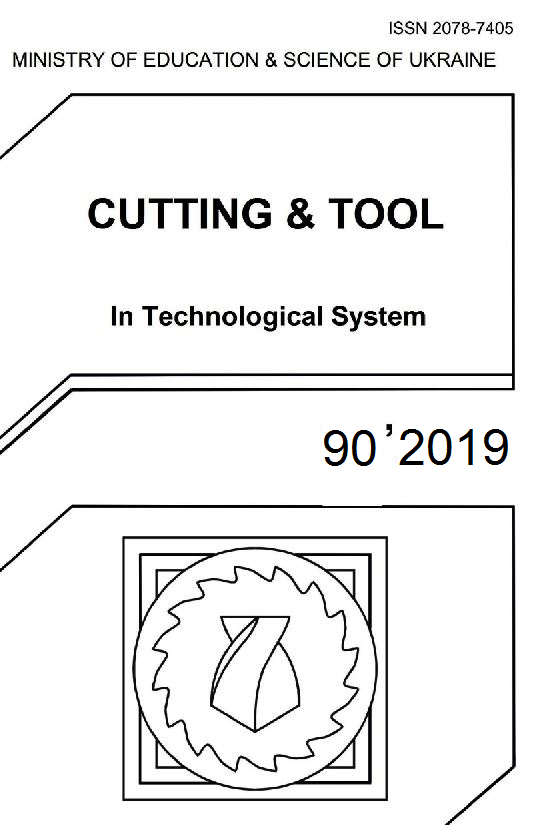INCREASE EFFICIENCY OF INTERRUPTED GRINDING PROCESS
DOI:
https://doi.org/10.20998/2078-7405.2019.90.18Keywords:
parametric instability, intermittent lap, grinding temperature, discontinuity factor, cutting area, elastic system of the machine.Abstract
. Grinding is the most common method for machining hardened steel parts. However, due to the high thermal stress of the grinding process, various defects appear on the machined surfaces, significantly reducing the operational reliability of the parts produced. One of the effective ways to improve the quality of the surface layer and the performance of grinding is the use of abrasive tools with a discontinuous working surface. But the incorrect application of these circles often leads to the formation of additional defects on the surfaces being treated — waviness and technical burns. The article reveals the conditions for the deterioration of the geometric and physico-mechanical parameters of the quality of the surface layer of parts in the grinding operation with abrasive wheels with a discontinuous working surface. The ways of improving the quality of the surface layer of parts with intermittent grinding are proposed. It has been established that when grinding with a discontinuous circle with grooves parallel to the tool axis, it is very difficult to prevent the occurrence of grinding defects due to constantly changing processing conditions (changing the parameters of the cutting mode, filling the working surface of the wheel), resulting in the appearance of parametric grinding in the elastic surface grinding machine. On the basis of theoretical and experimental studies, the expediency of using abrasive wheels with spiral grooves or inclined grooves on working surfaces in an operation is determined.References
Novikov F.V. K voprosu o suschnosti preryivistogo shlifovaniya / F.V. Novikov, A.A. YAkimov // Rezanie i instrument v tehnologicheskih sistemah: Mejdunar. nauch.-tehn. sb. – Harkov: NTU «HPI», 2001. – № 60. – pp. 177-182.
YAkimov A.V. Otsenka effektivnosti primeneniya preryivistogo shlifovaniya / A.V. YAkimov, A.A. YAkimov // Fizicheskie i kompyuternyie tehnologii: trudyi 19-y mejdunar. nauch. – prakt. konf. – Harkov: HNPK «FED», 2014. – pp. 61-66.
YAkimov A.V. Stabilizatsiya tehnologicheskih parametrov protsessa shlifovaniya zubchatyih kolёs / A.V. YAkimov, A.A. YAkimov // Suchasne mashinobuduvannya: jurnal asotsіatsії tehnologіv – mashinobudіvnikіv Ukraїni. – Kyiv: ІVTS, ІNM іm. V.M. Bakulya NAN Ukraїni, 2000. – №1 – 2 (3-4). – pp. 105-113.
Lischenko N.V. Opredelenie temperaturyi preryivistogo shlifovaniya / N.V. Lischenko, V.P. Larshin, A.V. YAkimov // Pratsі Odeskogo polіtehnіchnogo unіversitetu: Naukoviy ta naukovo-virobnichiy zbіrnik. – Odesa: ONPU, 2012. – Vip. 2 (39). – pp. 80-85.
Svirschёv V.I. Ob ustoychivosti upru goy sistemyi ploskoshlifovalnogo stanka ZG71 / V.I. Svirschёv, A.N. Parshakov, V.I. Potёmkin // Povyishenie kachestva detaley pri okonchatelnyih metodah obrabotki: mejvuzovskiy sb. nauch. tr. – Perm: Perm. politehn. ins., 1977. – №208. – pp. 42-50.
Tonkonogiy V.M. Dinamika preryivistogo shlifovaniya / V.M. Tonkonogiy, A.A. YAkimov, L.V. Bovnegra // Rezanie i instrument v tehnologicheskih sistemah: Mejdunar. Nauch.-tehn. sbor. – Harkiv: NTU «HPI», 2015. – Vip. 85. – pp. 288- 295.
Tonkonogiy V.M. Raschёt amplіtudі kolebaniy pri preryivistom shlifovanii / V.M. Tonkonogiy, A.A. YAkimov // Suchasnі tehnologії v mashinobuduvannі: zbіrnik nauk. pr. – Harkіv: NTU «HPІ», 2015. – Vip. 10. – pp. 63- 70.
YAkimov A.A. Rasshirenie vozmojnosti ispolzovaniya preryivistyih shlifovalnyih krugov na keramicheskoy svyazke /
A.A. YAkimov, V.M. Tonkonogiy, L.V. Bovnegra, V.M. Tigarev // Suchasnі tehnologії v mashinobuduvannі: zbіrnik nauk. pr. – Harkіv: NTU «HPІ», 2016. – Vip. 11. – pp. 64-73.
Tonkonogiy V.M. Predotvraschenie vozniknoveniya parametricheskoy neustoychivosti v usloviyah shlifovaniya vyisokotochnyih zubchatih kolёs preryivistyimi elborovyimi krugami /
V.M. Tonkonogiy, S.YU. Dmitrieva, A.A. YAkimov // Suchasnі tehnologії v mashinobuduvannі: zbіrnik nauk. pr. – Harkіv: NTU «HPІ», 2014. – Vip. 9. – pp. 206-215.
Naddachin V.B. Prichinyi vibratsii shpindelnoy sistemyi stanka i ih vliyanie na protsess shlifovaniya / V.B. Naddachin // Fizicheskie i kompyuternyie tehnologi v narodnom hozyaystve: trudyi 6 – y mejdunar. nauch.-tehn. konf. – Harkiv: HNPK «FED», 2002. – pp. 140-143.
Lukin L.L. Raschёt preryivistyih krugov pri ploskom periferiynom shlifovanii / L.L. Lukin, V.D. Starshev // Vestnik Ij. GTU. – 2007. – №1. – pp. 38-39.
YAkimov A.V. Optimizatsiya parametrov protsessa shlifovaniya preryivistyimi krugami s ravnomernyim kontaktom / A.V. YAkimov, A.A. YAkimov, S.YU. Dmitrieva // Vіsn. Harkіv. nats. tehn. unіv-tu sіlsk. gosp-va іm. Petra Vasilenka: Zb. nauk. pr. – Harkіv: HNTUSG, 2007. – Vip. 61. – pp. 34-39.
YAkimov A.A. Tehnologicheskie osnovyi obespecheniya i stabilizatsii kachestva poverhnostnogo sloya pri shlifovanii zubchatyih kolёs / A.A. YAkimov. – Odessa: Astroprint, 2003, – 456 p.
YAkimov A.A. Issledovanie temperaturyi pri shlifovanii krugami so spiralnyimi kanavkami na periferii / A.A. YAkimov, O.A. YAkimova // Suchasne mashinobuduvannya: jurnal asotsіatsії tehnologіv-mashinobudіvnikіv Ukraїni. – Kyїv: RІTS ІNM
іm. V.M. Bakulya NAN Ukraїni, 1999. – №2. – pp. 65-68.
YAkimov A.A. Issledovanie temperaturyi pri shlifovanii krugami so spiralnyimi kanavkami na periferii / A.A. YAkimov, F.V. Novikova, S.YU. Dmitrieva, V.P. Kulіk // Vіsnik Harkіvsk. derj. tehnіch. unіv-tu sіlsk. gosp-va: Naukove vidannya. – Harkіv: HDTUSG, 2003. – Vip. 18. – pp. 114-110.
Downloads
Published
Issue
Section
License
Copyright Notice
Authors who publish with this Collection agree to the following terms:
1. Authors retain copyright and grant the Collection right of first publication with the work simultaneously licensed under a Creative Commons Attribution License that allows others to share the work with an acknowledgement of the work's authorship and initial publication in this Collection.
2. Authors are able to enter into separate, additional contractual arrangements for the non-exclusive distribution of the Collection's published version of the work (e.g., post it to an institutional repository or publish it in a book), with an acknowledgement of its initial publication in this Collection.
3. Authors are permitted and encouraged to post their work online (e.g., in institutional repositories or on their website) prior to and during the submission process, as it can lead to productive exchanges, as well as earlier and greater citation of published work.

